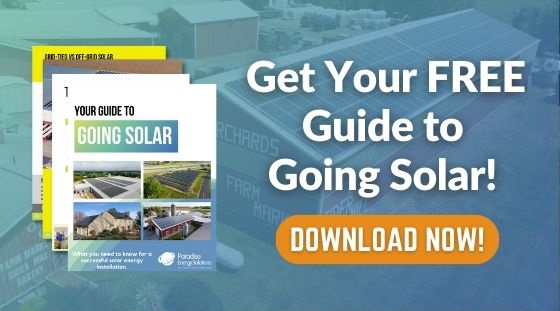How To Choose the Right Solar Inverter: A Comprehensive Guide
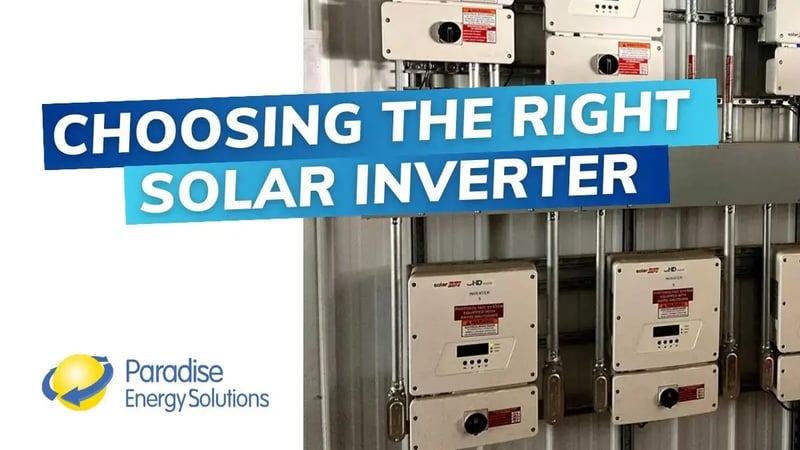
Solar inverters are an essential component of a solar system. These complex bits of technology turn the direct current (DC) power generated by your solar panels into electricity you can use for your business, home, or farm.
They’re also the part of your solar system that’s likeliest to fail first. Because of that, the type of inverter you choose to have installed on your solar system is an important decision. You want an inverter that maximizes your system’s production while having a low failure rate and a good warranty.
In this blog, we’ll share the information you’ll need to help make an informed decision regarding which kind of inverter is best for your solar system.
The Three Types of Solar Inverters
Ultimately, your decision comes down to which of the three solar inverter types is the most beneficial for your solar system:
Before we get into each type, we want to touch on the main differentiator between them: converting DC electricity on a string level or converting on a panel level.
With string inverters, the electricity produced by entire groups, or strings, of your panels are converted together. On the other hand, string inverters with optimizers and systems with microinverters offer module-level optimization, which means the power from each individual solar panel is converted separately. Microinverters do this by converting power from DC to AC for each module, while optimizers are essentially a DC-DC converter that allows the power from each module to be harvested separately.
Each type has its own pros and cons, which you should weigh against one another to make your decision.
String Inverters
String inverters, which you may also see referred to as centralized inverters, are the most common, and often the most cost-effective, type of inverter. Your solar panels are arranged in rows or groups called strings. String inverters convert the DC energy produced by each string of solar panels into AC power.
Cost
String inverters tend to be the most affordable option. Some smaller commercial systems and some residential systems may find the more expensive microinverter to be worth the increase in price. However, this is often not the case on larger projects.
Reliability and Warranty
String inverter technology has been used since solar energy’s early days, lending credence to its reliability. However, failure rates will vary from brand to brand.
At Paradise Energy, we most often offer SMA string inverters. With nearly 40 years of inverter design and manufacturing under their belt, they not only have the experience to ensure they’re producing a quality product, but they also have financial stability. That’s important because financially stable companies are more likely to be around to honor their warranties.
Out of the gate, SMA inverters come with a ten-year standard warranty, with the option to extend it for five or ten years. For 2020, SMA has updated its residential inverter line to extend the standard warranty to 15 years at no additional cost!
Ease of Maintenance
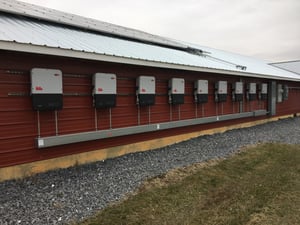 With string inverters, all of the equipment is located at ground level, whether your system is installed as a ground mount or a roof mount. While many solar inverters are reliable and can fall under warranty for 20+ years, they are the piece of your solar system likely to have problems first.
With string inverters, all of the equipment is located at ground level, whether your system is installed as a ground mount or a roof mount. While many solar inverters are reliable and can fall under warranty for 20+ years, they are the piece of your solar system likely to have problems first.
Because of that, ground-level equipment makes it easier for operations and maintenance (O&M) teams to access your solar system in case anything goes wrong.
Aesthetics
While ground-level technology is preferred from a maintenance standpoint, it may not be from an aesthetics standpoint. While they’re not particularly large (a little smaller than the size of a standard residential electrical panel), string inverters will take up space somewhere on or in your home or business. And if you have a large system, you will need more than one inverter.
Depending on how streamlined you’d like your system to look, or whether or not you have a good place to install the inverter(s), microinverters may be your preferred option.
Shade Mitigation
Because string inverters convert electricity for groups of solar panels, you may lose out on some electricity production if your roof is shaded. This is because the inverter must convert an equal amount of electricity from each panel in the string. So if one panel is partially shaded and produces less electricity because of the shade, the inverter will only convert that amount of electricity from all other panels in the string, regardless of whether or not they’re shaded.
For example, say there are four solar panels in a string. A nearby tree shades half of one of the four panels for a few hours a day, while the remaining three panels are in full sun. With a string inverter, all four panels will be limited to half production while that one panel is shaded. This only applies to panels in that string. There can be more than one string connected to one inverter.
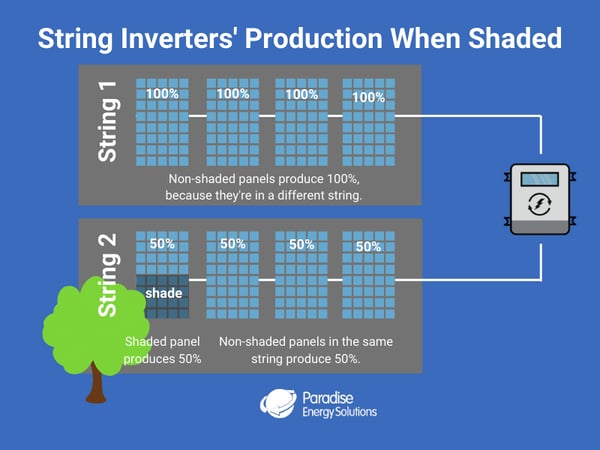
So the roof where your solar system will be installed is partially shaded, you may want to reconsider going with a string inverter, depending on the size of your system, as you could lose out on some electricity.
Microinverters
 Microinverters convert your solar panels’ DC electricity into AC electricity on a module level. While string inverters convert electricity for several solar panels and are located separately from the panels at the ground level, microinverters are installed underneath each individual panel, preferably on the racking of the system.
Microinverters convert your solar panels’ DC electricity into AC electricity on a module level. While string inverters convert electricity for several solar panels and are located separately from the panels at the ground level, microinverters are installed underneath each individual panel, preferably on the racking of the system.
Cost
Compared to string inverters and string inverters with power optimizers, microinverters are oftentimes the most expensive option. Because of this, they are not typically used on larger solar installations.
Reliability & Warranty
Compared to string inverters, microinverters are a newer technology. This doesn’t necessarily mean that they’re less reliable, but there will be more of them up on your roof, which means more opportunities for failure to occur.
At Paradise Energy, we offer mostly Enphase microinverters. Throughout the years, Enphase has continually streamlined its microinverters with fewer parts, which reduces its failure rate, making it a great option.
Additionally, Enphase microinverters are backed by a 25-year warranty - the most robust in the solar industry.
Ease of Maintenance
String inverters are easy to access for maintenance because they’re located at the ground level. But with microinverters, this isn’t the case. Each panel has a small inverter tucked underneath. That means if they’re having problems, your maintenance team will have to get up on your roof and remove panels to access the inverters that are having issues.
Aesthetics
Microinverters eliminate the need to have a string inverter somewhere inside or outside your building. About the size of an internet router, a microinverter is neatly tucked under your solar panels out of sight. However, microinverters will require a combiner box at ground level.
Shade Mitigation
One of the biggest benefits of microinverters is their ability to convert DC electricity to AC electricity for each individual panel. That means if just one of your eight solar panels is half-shaded, only the shaded panel’s production will be limited, and the other seven panels will produce full electricity.
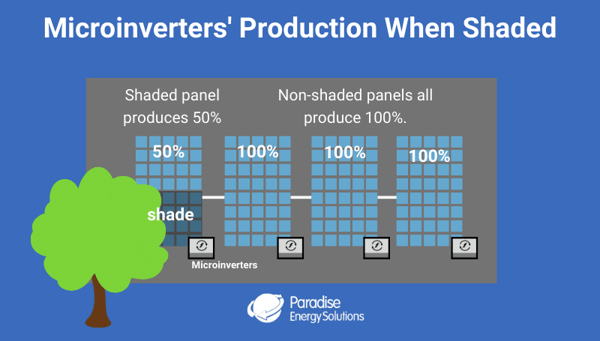
Depending on how much shade your roof has, this may make microinverters the better choice, even if they are more expensive than a string inverter initially. They’ll also offer module-level monitoring, meaning you can see how much electricity each solar panel is producing on your monitoring software. With string inverters, you’ll only be able to see how much electricity each string is producing.
String Inverters With Power Optimizers
You can think of optimizers as somewhere between string inverters and microinverters. Like microinverters, these offer module-level power electronics. However, they do so with the inclusion of a string inverter.
Optimizers are small devices that will be installed underneath each panel, similar to microinverters. But instead of converting the sun’s power from DC to AC right at the panel, they’ll send it to the string inverter.
Cost
A system that utilizes string inverters and power optimizers is often a more affordable option than a system that uses just microinverters. But compared to a stand-alone string inverter, you will have the added costs of the power optimizers themselves, making them a more expensive option.
Reliability & Warranty
Power optimizers are reliable, well-designed pieces of equipment, which are backed by the reliability of string inverters.
At Paradise, we typically use either SolarEdge string inverters with SolarEdge optimizers or SMA string inverters with Tigo optimizers. After years of experience, we feel that both offer an exceptional amount of reliability and are backed by solid warranties.
SolarEdge offers a 12-year warranty on its string inverter, which can be increased by eight to 13 years with an extended warranty. The optimizers come with a 25-year warranty. SMA string inverters will have a ten-year standard warranty, with a five- to ten-year extended warranty option. For 2020, residential inverters come with a 15-year standard warranty at no extra cost. Tigo optimizers also come with a 25-year warranty.
Ease of Maintenance
Power optimizers are a hybrid of ground-level and roof-level technology. While the string inverter will be located at ground level, the power optimizers will be installed underneath each solar panel.
Should something go wrong with the power optimizers, your maintenance team will have to get up on your roof and remove panels to get to them. However, if something goes wrong with the string inverter, they’ll be able to troubleshoot and fix the inverter without removing the panels.
Aesthetics
Unlike microinverters, which tuck away the inverter equipment underneath the solar panels, power optimizers still require a string inverter or inverters at ground level somewhere on your property. However, they do offer increased production on a shaded roof for less than the cost of microinverters.
Shade Mitigation
String inverters with power optimizers offer the same shade mitigation as microinverters, making them a great option for cost-conscious solar owners with shady roofs.
The power optimizers will allow each solar panel to contribute power based on how much each panel is actually producing, as opposed to the lowest-producing panel in the string. They will also give you a deeper look into your solar system with module-level monitoring.
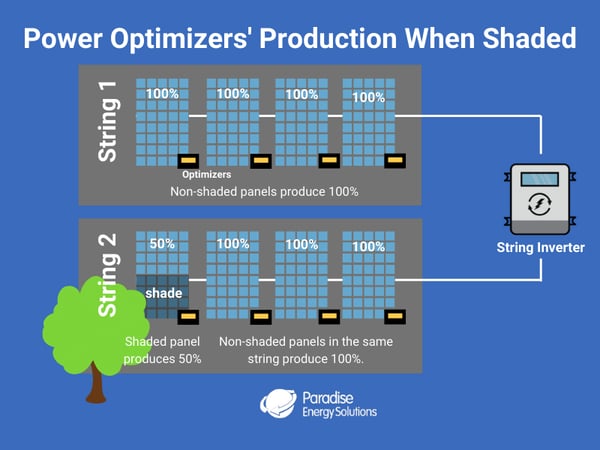
What Type of Solar Inverter is the Best?
We’re confident that an SMA string inverter, Enphase microinverters, SolarEdge string inverter/optimizers, and SMA string inverter/Tigo optimizers are all high-quality and reliable pieces of equipment backed by strong warranties. It’s hard to say one is overall superior to the rest.
It really comes down to your specific solar project and your goals for that project.
If you’re installing a system that’s 20 kW or more, string inverters are probably your best bet, as they’re the most scalable option. If you have a typical-sized home and have some shading on your roof, microinverters or solar optimizers may make the most sense.

